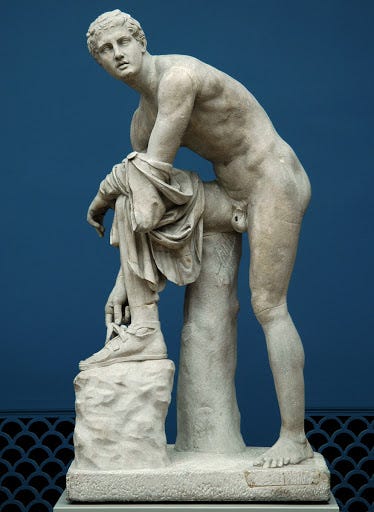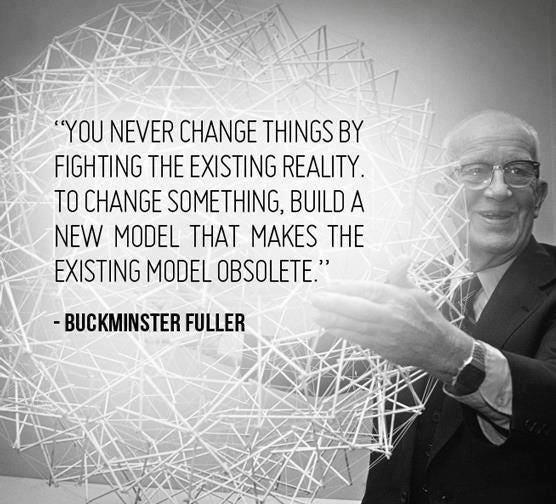Hello, it’s Kevin. Here is your weekly list of 5 things I’ve found that promote wholeness, integration and “waking up” - rather than fragmentation, dis-integration and falling asleep.
This week’s newsletter is on mental models and not-so-mental models.
Everybody has an internal model of posture that is guiding their movements like an invisible puppet master. But most of it was designed by a two year old using the best tools he had at the time.
So it might need a little updating…
BOOK:
Model-Based Reasoning in Scientific Discovery - edited by Lorenzo Magnani, Nancy J. Nersessian, Paul Thagard
I don’t really like mentioning “mental models” because of the way it gets used and abused online by productivity junkies and silicon valley types. But I use models in my work every day, and this book is a great source for papers on the concept.
I was asked why I believe my idea of “correct posture” is true and not just an opinion. The answer is that I don’t claim it is “true” - it is a model. I use the model to plan and guide movements, then I use the model to analyse and judge the results. The model can and does change over time. If it works, it stays.
Everyone has an internal model of posture that is guiding their movements like an invisible puppet master. But this model is a chaos of feelings, sensations, pre-conceptions, uncontrolled inner speech, mental images etc., plus a few snippets of explicit advice they have heard over the years. It is habitual and mostly subconscious. You can’t change your posture until you change this underlying model. This is the same process used in scientific discoveries.
My aim in the 1-to-1 lessons is to bring some order to this chaos.
To give you a new conscious (reasoned) model so you can do something new, rather than just be a slave to your old subconscious (unreasoned) model. Then it is up to you how you apply it and what you change.
It doesn’t matter if you don’t agree with the model or the exact positioning of specific body parts - because once you can consciously guide your own movements in this way you can create any model you want.
Confession: I have lost a few pupils because they just couldn’t cope with the weirder parts of the model I use!
ART:
I think the ancient Greeks used sculptures as mental models - as 3d diagrams - to teach and preserve important PRINCIPLES & RULES of movement. Do we honestly think the culture most obsessed with both geometry and athletics just kept them in separate departments like we do, and didn’t apply mathematics directly to movement?
Not to mention how much of their mathematics and philosophy came out of war preparation and athletic training. It is impossible to separate them. The Greeks got psychophysical.
If you don’t like war, fine. But you can’t have the rose of philosophy without the thorn of war.
Let’s look at “Hermes Fastening his Sandal”
As well as the mythological meaning here, Hermes is teaching us that you don’t need to collapse and fold the body when bending over - you can lengthen and expand the body.
Look how long his torso remains even while reaching down to his sandal. Look at the shape of his abdomen - not the muscles, the structure.
His internal model of posture is different from ours. I can see it in the shape his movements are making, and this shape won’t happen by itself “naturally.” He is moving according to rules. You can’t feel rules.
There is a very specific structure, order and system of relations between bony parts here - which I am certain cannot happen by accident or by “physical exercise” alone. (I teach this structure to my posture pupils and a technique for achieving it.)
I do not mean that the Greeks copied or imitated the statue. I mean they learned the principles and rules by studying the “model,” and then applied them to their own movements and activities.
This process of reasoning out the geometry of the whole, organising the relations between the different parts, and performing the necessary movement in space to match the model is, for me, the real “embodiment” - psychophysical embodiment - and is much more reliable than your fleeting feelings and sensations, however pleasant.
QUOTE (1):
Mental models & Not-so-mental models.
“When I ask the pupil to do something, the pupil must get a mental conception of what is wanted. If the pupil goes on then to get a sensory conception of how to do it, it will be wrong.”
“Sensory appreciation conditions conception—you can’t know a thing by an instrument that is wrong.”
F. Matthias Alexander
QUOTE (2):
Almost everything people do to fix their posture is fighting the existing reality.
Lifting weights to build muscles to “fight” gravity better. Trying to remember to stop slouching and “stand up straight with your shoulders back.” Or relaxation techniques to reduce muscle tension.
None of these change your underlying model of the human postural system. First, you need to build a new model of the human postural system in your mind. Then you can use this “mental” model to change your “physical” posture. (I teach a specific technique for doing this in the 1-to-1 zoom lessons.)
EXPERIMENT:
“Fastening your sandal.”
The purpose of this experiment is to demonstrate that you are using a different internal model than Hermes.
Record yourself side on to the camera (visible from head to toe) and put your foot on a box or small chair, roughly the height of your calf muscle.
Fasten your “sandal” or reach down to whatever (hopefully minimal) footwear you are wearing today.
Take a screenshot of the video and put it side by side with Hermes.
Compare your structure to Hermes, especially the relative position of the shoulders, lower back, and abdomen — are you collapsing or lengthening the torso?
If you are collapsing, what “pre-conceptions” must be part of your internal model?
Have fun learning how to tie your shoe laces again.
Thanks for reading,
Kevin
P.S.
Do you want to learn how to stop your posture getting worse as you get older?
I will help you build a new mental model of your postural system and teach you a technique for changing it by yourself - without weights, devices or “bodywork” therapies.
To book this 1-to-1 consultation reply to this email, or message me on Twitter.



